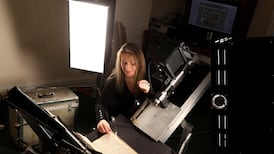A prize-winning competition essay led a young Irish chemist straight to an American research post in solar cell studies, reports Dick Ahlstrom.
A young Irish researcher has transferred expertise gained during his PhD studies at Trinity College Dublin into a new posting with the US Department of Energy in Colorado. It involves the study of novel ceramic materials that could help deliver the next generation of solar cells.
Dr Aron Walsh completed his PhD in November 2006 and early in 2007 departed to work as a post-doctoral researcher at the National Renewable Energy Laboratory (NREL) near Silver Springs, Colorado.
The work done at Trinity was directly applicable to the solar cell studies underway in the US, Walsh says. The research also helped him to pick up a valuable award last month from the Royal Irish Academy (RIA) in Dublin.
Walsh captured the annual Prize for Young Chemists presented by the RIA and sponsored by The Irish Timesand AGB Scientific. Entrants are asked to write a short essay that describes their thesis work in ordinary language. Walsh's essay claimed the top prize, worth €1,000, and also a bronze statue.
The Colorado lab is studying hydrogen production from water using solar cells as a source of electricity, needed to break the water molecules into oxygen and hydrogen. Walsh studies and characterises novel new ceramic materials that could be used to increase photovoltaic efficiency and reduce the costs associated with solar cells.
Walsh's PhD work was quite similar, looking at the structure of metal oxides and inorganic ceramics and how structure affected the properties of these substances.
"We were trying to establish the relationship between the chemical structure and their physical characteristics," he explains. Structure has an influence on a variety of aspects, including ceramic hardness, colour and conductivity.
Modelling was used to build the link between structure and a substance's electrons and the resultant characteristics of the material.
"We modelled individual atoms within a solid and predicted what happens on a larger scale," he says. "We looked at where the electrons are and looked to see how the position of the electrons changes the characteristics."
This complex modelling is dependent on quantum mechanics and could only be achieved because of the availability of powerful computers, Walsh says. Prior to the availability of these systems, researchers could only make approximations about structural aspects. In turn, computer "muscle" has allowed the development of novel ceramics, including transparent ceramics that can still function as solar cells.
Walsh's Trinity group studied materials with known unusual properties, attempting to understand how structure influenced these properties.
"We took these anomalies and used the latest methods to understand what was happening within these structures," he says. These methods included density functional theory (DFT), used specifically in quantum mechanical theory to study atoms, molecules and condensed materials such as ceramics.
The team got a boost when a group at Oxford University was able to confirm some of the predictions coming from Walsh's work. "For the first two years it was predictions, but using the synchrotron at Oxford they actually verified what we predicted."
Much of this expertise now transfers readily to the US, he adds, where he is trying to understand these new materials and how they might be modified. "We are manipulating the properties to tune particular properties for the needs of renewable energy," says Walsh.
Entries for the 2008 Prize for Young Chemists competition will close on Mon, Jan 14. Entrants are asked to e-mail a 1,000-word essay describing their PhD research to chemists@ria.ie along with two academic references. Details and conditions of the competition are available on the Royal Irish Academy's website, www.ria.ie










